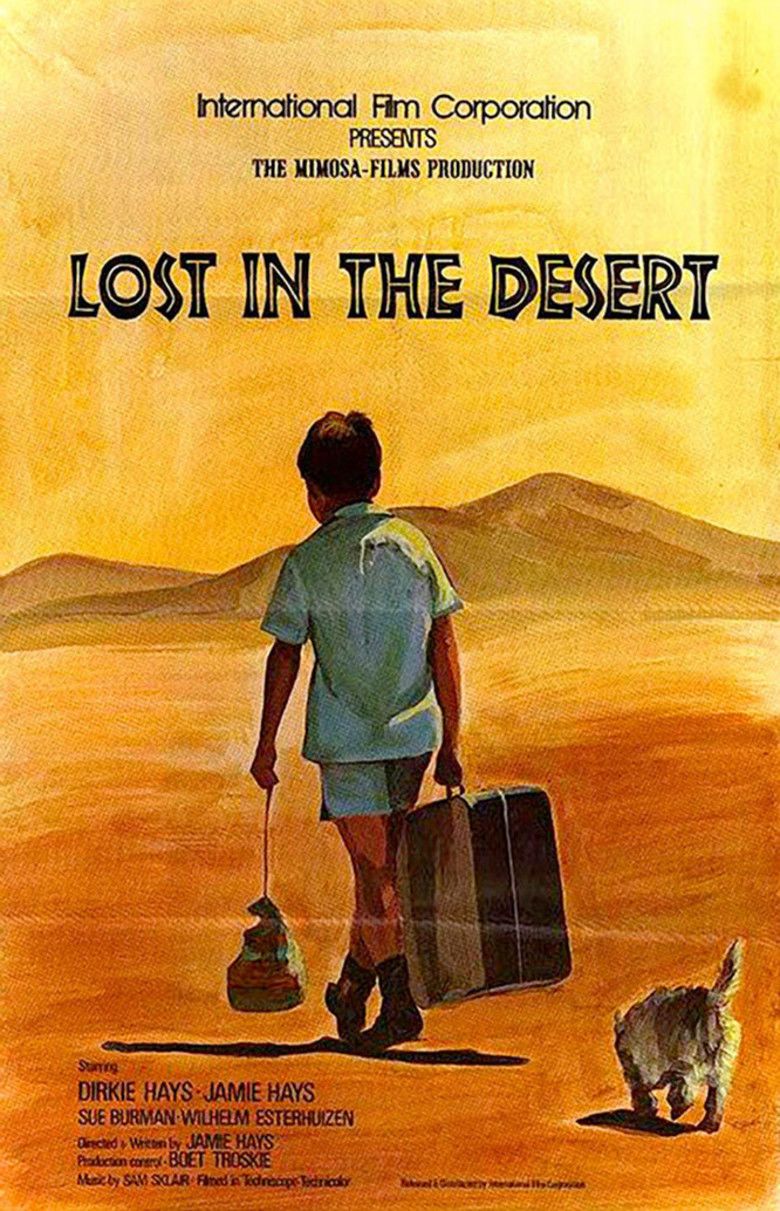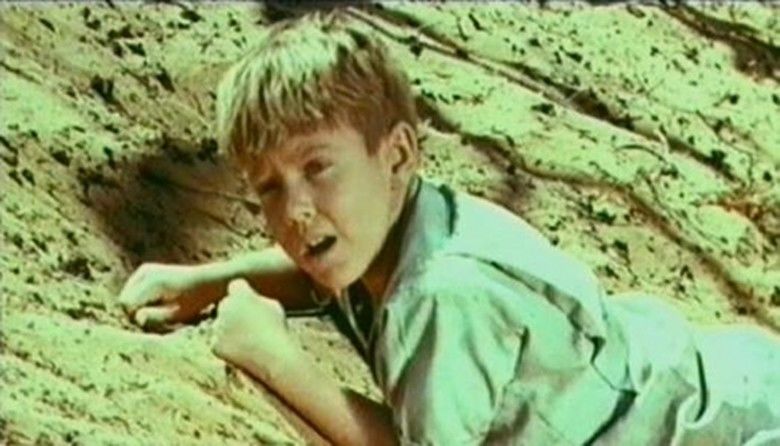Lost in the Desert
7.4 /10 1 Votes
Duration Country South Africa | 7.2/10 IMDb Genre Adventure Film Language EnglishAfrikaans | |||||||||||||||||||||||||||||||||
 | ||||||||||||||||||||||||||||||||||
Cast Wynand Uys (Dirkie), Jamie Uys (Anton), Lady Frolic of Belvedale (Lolly), Wilhelm Esterhuizen (Smitty), Sue Burman (Joan), Jan Bruijn (Colonel)Release date Australia:27 August 1970Sweden:19 December 1970 Similar movies Leatherlip , Holes , A Kalahari Family Part One: A Far Country , A Kalahari Family , Away We Go , The Kid Tagline Few have ever entered the deadly, mysterious Kalahari, and lived to reveal its secrets! | ||||||||||||||||||||||||||||||||||
A boy and his dog wander through the Kalahari after a plane crash in southern Africa.
Contents
- Plot
- Music
- Cinema release
- Reactions and legacy
- Differences between the two language versions
- Telugu remake
- References

Lost in the Desert, initially released as Dirkie, is a South African film from 1969/1970, written, produced and directed by Jamie Uys under the name of Jamie Hayes.

Uys himself plays Anton De Vries, a concert pianist whose 8-year-old son Dirkie is the central character. Dirkie is played by Uyss real-life son Wynand Uys, credited as Dirkie Hayes.

An 8-year-old boy and his dog are left to face a vast desert wasteland alone after a plane crash, while an army of men and machines penetrate the desert searching for them. Based on true events.
Plot
The story is about 8-year-old Dirkie DeVries (Wynand Uys, credited as Dirkie Hayes), who is flying with his Uncle Pete (Pieter Hauptfleisch) across the Kalahari Desert in a small plane, piloted by Uncle Pete, who partway into the flight has a heart attack and partially loses control of the plane. Thanks to his struggles to land safely in the desert even while suffering the heart attack, the crash is not as serious as it might have been otherwise, and, while Pete himself dies, Dirkie and his small pet dog survive, and the bulk of the story follows Dirkies various adventures while he struggles to survive the harsh desert conditions, including an encounter with Kalahari Desert Bushmen, who give him help, but abandon him after an unfortunate misunderstanding concerning Dirkies dog.
The story switches several times to Dirkies father Anton DeVries (played by the director Jamie Uys, credited as Jamie Hayes) and follows his increasingly desperate efforts to locate his son, including having a couple of million leaflets specially printed and spread over the desert from a plane, containing instructions for Dirkie on how to survive in the desert, and assuring him that his father loves him and wont give up trying to rescue him. The film features the unusual technique of showing Anton playing the piano, then switching to Dirkie in the desert while continuing to use the piano music as background music for the following desert scenes.
Ultimately Anton travels to the Kalahari Desert himself after everything else fails to make progress. (He has had to mortgage his house to pay for the expenses of finding Dirkie after a newspaper backs out of an earlier offer to assist with expenses.) In the desert, he meets one of the Bushmen who had earlier met Dirkie, and gets information about the direction Dirkie was last seen going in, and he is finally able to find Dirkie, who looks as if he is close to death. His dog is still with him, although injured. The film ends with Dirkie (unconscious) in his fathers arms, together with his little dog (still alert), both being carried back to the vehicle his father had travelled there in.
The DVD re-issue states that the film is based on a true story.
Music
Music plays a very important role in this film, especially classical piano music resulting from Dirkies father being a concert pianist. Classical piano music is used several times in the films soundtrack: particularly compositions by Franz Liszt and Frederic Chopin, to the point that Liszts Liebestraum no. 3 in A-flat major (S./G. 541, R. 211, no. 3) and Chopins Polonaise no. 6 in A-flat major, op. 53 ("Polonaise heroique") almost become de facto themes for the film.
Some of the climactic portions of the Liebestraum form a sweeping sonic backdrop to early scenes in the desert (before the crash landing), showing a lunch stop in the empty desert and then taking off and resuming the flight.
There is a striking and emotionally intense scene in which Dirkies father is practising the Polonaise at home and his worry about Dirkie causes him to have a sudden emotional breakdown, in which he interrupts his playing by hitting the pianos keyboard angrily with his fists and producing loud crashing discords.
In addition, the very opening scene of the actual story (after the differing introductions to the two versions of the film) shows Dirkie and his father playing Chopsticks together on the piano as a duet.
Other than classical pieces, original music for the film was composed by Art Heatley and Sam Sklair with a faux African musical cue by William Loose. One German web site also credits Gilbert Gibson as another composer for the film. However, the DVD credits only Sklair for original music.
The Australian jazz singer Edwin Duff (1928-2012) is credited in the end titles as singing the theme song "Wait for Tomorrow". However current versions of the movie do not include the song.
Cinema release
There is disagreement about whether the English-language version appeared in 1969 or 1970. This discrepancy may possibly be due to different release dates in different English-speaking countries, although complete certainty about this does not seem to be available.
It was released in the UK with The Golden Voyage of Sinbad as a support feature in 1974. This is confirmed by those who saw it at a young age in several forums, including IMDb.
Reactions and legacy
The film was not widely available for many years after its original release, but discussions on film-related forums and personal blogs show that aspects of the film are remembered very vividly and with horror by those who saw it as children.
Discussions and memories of the film posted online suggest that viewers appear to have been haunted by scenes from the film for many years, without being able to identify the film itself. Certain scenes are regarded with some unease or horror, possibly even casting doubt on whether the film is suitable for children, although its overall style seems to suggest that it was conceived as a childrens film.
Lead actor Wynand Uys did not act again. He is now in his fifties and runs a nature reserve and outdoor activity centre near Hoedspruit, South Africa.
Director Jamie Uys became best known outside South Africa for making the first two films in The Gods Must Be Crazy series. He died in 1996.
The film was released on DVD in 2005. On the cover the credits for Jamie Hayes and Dirkie Hayes use their real family name Uys.
Differences between the two language versions
Lost in the Desert was shot in two versions, one in Afrikaans and the other in English. The Afrikaans version appeared in 1969 under the title Dirkie, and the English version appeared in either 1969 or 1970 (possibly according to which country) under the title Dirkie Lost in the Desert, which was sometimes referred to and marketed as Lost in the Desert, which is possibly an alternative official title for the English version.
The film was released on DVD in 2005 (copyright 1999), and this disc contains both versions of the film, selectable from the front menu. The English version is about 70 minutes long, and the Afrikaans version rather shorter.
Most of the scenes are exactly the same in both versions, but both contain a few scenes which are not included in the other. For example, the Afrikaans version starts with a scene showing Dirkies father Anton Hayes, who is a concert pianist, playing Frederic Chopins Fantaisie-Impromptu in C-sharp minor, Op. 66 (posth.) before an audience. Instead of this, the English version substitutes some panoramic scenes from the Kalahari Desert (the setting for most of the story), with an announcer narrating a brief history of the desert. One possible reason for this difference might be that the director may have thought that an English-speaking audience might find a little introductory information about the Kalahari Desert useful, but that an Afrikaans audience might find it superfluous. The opening concert scene in the Afrikaans version adds nothing to the story beyond establishing the fact that Dirkies father is a concert pianist.
Also, the presence or absence of music during a prominent scene early in the film differs between the two versions.
There are also a few very brief scenes, some only of seconds duration, that are in one version of the film but not the other. However, overall the Afrikaans version is significantly shorter, thus suggesting that the English one may be more "complete".
One account of the film in discussion forums suggests that, in the 2005 re-release of the film on DVD, the reason for the Afrikaans version being shorter might be that the last reel of this version was lost and so the film was simply truncated on DVD, thus accounting for its reportedly abrupt ending.
Telugu remake
A hugely popular remake was made in Telugu, A South Indian language in 1972 with the name Papam Pasivadu with a few minor changes in the storyline to suit the local audience.
References
Lost in the Desert WikipediaLost in the Desert IMDb Lost in the Desert themoviedb.org
